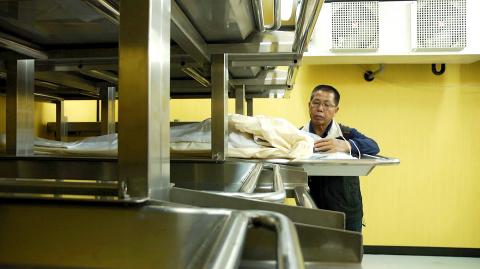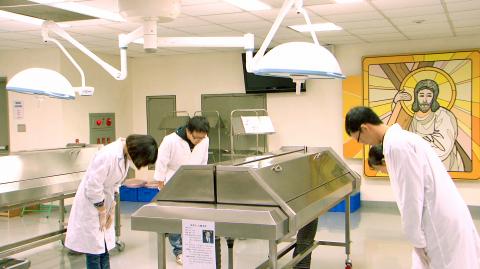Don’t be put off by the dead body in the opening scene of Silent Teacher — you’ll likely be moved to tears later. No exaggerating here, there was much sobbing heard during the screening. Director Maso Chen (陳志漢) tackles a potentially morbid subject with sensitivity, crafting a tender and informative documentary on “silent teachers” (大體老師), or people who have donated their body to medical schools for dissection.
Due to the traditional belief in keeping one’s corpse whole, medical schools in Taiwan often have difficulty finding cadavers for their students to dissect in anatomy classes. As a result, the cadaver-to-medical student ratio in Taiwan is five times lower than that of Western countries. Here, these bodies are literally treated as “teachers,” with the students bowing and thanking them after each session.
It could be argued that the film’s protagonist is Hsu Yu-e (徐玉娥), a Chiayi woman whose body is being prepared for dissection at Fu Jen Catholic University’s medical school (the process takes about a year), but the narrative is primarily told through Lin Hui-tsung (林惠宗), her husband of 23 years, who travels to Taipei every month to update his wife’s body on how the family is doing. Both of them had signed up to donate their bodies for education.

Photo courtesy of The Classic Vision
The film also places much attention on the medical students and staff, especially as they have to interact with their designated corpse’s family members, who are pretty much involved in every step of the process (except for watching the dissection, which they can’t bear to do).
The professor repeatedly stresses that the cadaver is more than just a body to dissect — it is a lesson in respecting life. And like the class, the scope of the film reaches way beyond the subject matter, which is clearly and cohesively presented — the director also explores deeper themes on life, death and humanity.
We hear their daughter discussing what she has learned about life from this experience, while the anatomy class professor ponders whether she can handle her students dissecting her own mother, who has volunteered to be a silent teacher when she dies. There’s also discussion of religion through how a Catholic university handles bodies from people with Buddhist or Taoist backgrounds. The cause of Hsu’s death is revealed indirectly as the students dissect her body.

Photo courtesy of The Classic Vision
Through masterful editing, much of the story is told through conversations and slice-of-life scenes — and there is much material to choose from as the director spent a year documenting Lin’s life, after Hsu’s body arrived at Fu Ren. For example, we only learn that he visits his wife’s body often through his casual banter with the medical staff. Lin is an ideal candidate for this type of story — he appears optimistic most of the time as we watch him try to carry on with his life — even posing for selfies in a karaoke bar. His positive attitude makes the film less heavy, but his grief is still there, and our hearts break when he breaks down.
Since there are essentially two timelines going on with the family and the medical school — which only converge every now and then — it makes for some interesting juxtaposition scenes that the director fully makes use of. And while the cadaver is frequently shown in the film, it is treated delicately but not too conservatively. We see just enough to realize that this is without a doubt reality, but not too much that we would feel uncomfortable.
Running just 73 minutes, there’s a lot packed into this film, but it doesn’t seem rushed — in fact it’s probably just long enough. When a viewer leaves the theater full of emotions, thoughts and new information without any hints of boredom — that’s all the signs of a good documentary.

The only geopolitical certainty is that massive change is coming. Three macro trends are only just starting to accelerate, forming a very disruptive background to an already unsettled future. One is that technological transformations exponentially more consequential and rapid than anything prior are in their infancy, and will play out like several simultaneous industrial revolutions. ROBOT REVOLUTION It is still early days, but impacts are starting to be felt. Just yesterday, this line appeared in an article: “To meet demands at Foxconn, factory planners are building physical AI-powered robotic factories with Omniverse and NVIDIA AI.” In other words, they used AI

Last month historian Stephen Wertheim of the Carnegie Endowment for International Peace published an opinion piece in the New York Times with suggestions for an “America First” foreign policy for Democratic presidential candidate Kamala Harris. Of course China and Taiwan received a mention. “Under presidents Trump and Biden,” Wertheim contends, “the world’s top two powers have descended into open rivalry, with tensions over Taiwan coming to the fore.” After complaining that Washington is militarizing the Taiwan issue, he argues that “In truth, Beijing has long proved willing to tolerate the island’s self-rule so long as Taiwan does not declare independence

Big changes are afoot in global politics, which that are having a big impact on the global order, look set to continue and have the potential to completely reshape it. In my previous column we examined the three macro megatrends impacting the entire planet: Technology, demographics and climate. Below are international trends that are social, political, geopolitical and economic. While there will be some impact on Taiwan from all four, it is likely the first two will be minor, but the second two will likely change the course of Taiwan’s history. The re-election of Donald Trump as president of the US

Nov. 25 to Dec. 1 The Dutch had a choice: join the indigenous Siraya of Sinkan Village (in today’s Tainan) on a headhunting mission or risk losing them as believers. Missionaries George Candidus and Robert Junius relayed their request to the Dutch governor, emphasizing that if they aided the Sinkan, the news would spread and more local inhabitants would be willing to embrace Christianity. Led by Nicolaes Couckebacker, chief factor of the trading post in Formosa, the party set out in December 1630 south toward the Makatao village of Tampsui (by today’s Gaoping River in Pingtung County), whose warriors had taken the